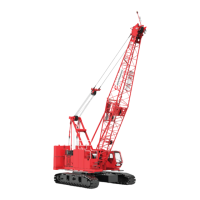Manitowoc Published 10-09-2020, Control # 259-06 2-19
MLC80A-1/MLC90A-1/MLC100A-1/MLC100-1 SERVICE/MAINTENANCE MANUAL HYDRAULIC SYSTEM
Changing Hydraulic Oil
Unless otherwise specified, refer to Figure 2-12 for the
following procedure.
Drain and refill the hydraulic system semiannually or every
1,000 hours of engine operation, whichever comes first,
unless an alternate interval has been established through an
oil analysis program.
1. Operate the crane until the hydraulic oil is at its normal
operating temperature. This helps remove impurities
from the system.
2. Stop the engine.
3. Vent the tank using either the Schrader valve (3) or the
vent valve (4).
4. Verify the shut-off valve (10) is open.
5. Place a suitable container capable of holding 302 L (80
gal) under the hydraulic tank.
6. Remove the drain plug (9) and completely drain the
hydraulic tank.
7. Discard the hydraulic oil according to local
environmental regulations.
8. Remove the access cover (8) from the hydraulic tank.
Take care to prevent dust and wind-blown dirt from
entering the tank while the access covers are off.
9. Clean out any sediment from inside the hydraulic tank.
10. Service the suction strainer if needed (see Servicing
Suction Strainer on page 2-17).
11. Replace the filter elements (see Replacing Hydraulic
Filters on page 2-16).
12. Replace the breather (see Replacing Breather on page
2-15).
13. Using a new seal, securely fasten the access cover to
the hydraulic tank.
14. Securely install the drain plug. Make sure the vent valve
in the plug is closed.
15. Fill the hydraulic tank to the Full Cold Level mark on the
oil level sight gauge (2). Use the proper hydraulic oil
listed in the Lubrication Guide.
Fill the tank through the fill plug (12) opening. Filter the
oil through an owner-supplied 10-micron filter.
16. Close the Schrader valve (3) and the vent valve (4).
17. Crack open the priming port (1, Figure 2-2, page 2
).
Close the port as soon as oil appears after the engine is
started.
18. Start the engine and allow the hydraulic system to reach
its normal operating temperature.
19. Check for leaks and correct them as required.
20. Stop the engine.
21. Check the hydraulic tank level and fill as required.
NOTE: If the hydraulic system was extremely dirty (gum or
lacquer formation on parts indicated by erratic,
jerky, or sluggish operation), repeat the procedure
after 48 hours of operation.
Servicing Pumps
It is not necessary to drain the hydraulic tank when servicing
the hydraulic pumps. To service the pumps, close the
hydraulic tank shut-off valve (10, Figure 2-12
).
CAUTION
Contamination Hazard!
Do not fill the hydraulic tank through the breather opening.
Harmful contaminants will enter the hydraulic system.
Damage to pumps and motors can occur.
CAUTION
Avoid Damage to Pumps!
Open the hydraulic tank shut-off valves before starting the
engine. Failing to perform this step will result in damage to
the pumps from cavitation.
